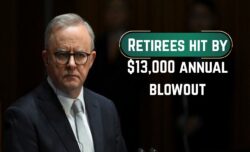Australia’s retirees are facing a serious financial challenge as the cost of retirement has surged significantly. According to recent reports, the average retirement bill has jumped by nearly $13,000 a year, putting many older Australians under pressure to reassess their budgets and lifestyle choices. Rising healthcare expenses, higher energy bills, and increased living costs are some of the primary reasons behind this budget blowout. For retirees depending on fixed pensions or superannuation, the sudden increase is causing concern and forcing them to explore new ways to manage their retirement income effectively.

Why Retirement Costs Are Rising in Australia
One of the major reasons behind the sharp rise in retirement bills across Australia is inflation. Essentials like groceries, rent, healthcare, and electricity have all experienced steep price hikes over the past year. Additionally, retirees are spending more on medical care and insurance premiums, which are outpacing general inflation rates. Many seniors also face unexpected costs such as home maintenance and fuel charges, which further strain their limited income. For households dependent solely on government support, the $13,000 annual increase has come as a heavy burden, prompting calls for urgent pension and allowance reforms.
Impact on Retirees and Their Families
The sudden increase in retirement expenses is not only affecting retirees themselves but also their families. Many adult children are stepping in to help cover costs for their aging parents, which adds financial pressure on younger households already battling their own cost-of-living challenges. Retirees are also cutting back on discretionary spending such as travel, dining out, or leisure activities to adjust to the new reality. This lifestyle shift impacts mental health and overall well-being. Moreover, seniors who rent instead of owning a home are especially vulnerable, as rental prices continue to rise in major Australian cities.
 Family Tax Benefit Part A and B 2025 Individual Payment Rates Announced for Australian Families
Family Tax Benefit Part A and B 2025 Individual Payment Rates Announced for Australian Families
Government Support and Financial Planning Options
To tackle the $13,000 retirement bill blowout, many retirees are exploring financial planning solutions and government schemes. The Australian government provides various support options, such as the Age Pension, energy bill rebates, and healthcare subsidies, but these benefits often fall short of covering the real costs. Financial advisors recommend that retirees revisit their superannuation strategies, investment portfolios, and budgeting habits. Community organisations also offer free financial counselling for seniors struggling to cope. Policy experts are urging the government to increase pension payments and expand subsidies to help retirees manage the growing cost of living.
Strategies Retirees Can Use to Cope With Rising Costs
- Reassess Superannuation: Review and optimise superannuation withdrawals to make funds last longer.
- Access Government Rebates: Apply for energy bill credits, healthcare cards, and rental assistance schemes.
- Cut Non-Essential Spending: Reduce discretionary expenses such as luxury travel and dining out.
- Consider Downsizing: Moving to a smaller home can lower maintenance, utility, and rental costs.
- Seek Financial Advice: Consult certified financial planners to structure savings and investments efficiently.

| Expense Category | Average Increase | Impact on Retirees |
|---|---|---|
| Healthcare & Insurance | $4,000 | Higher medical bills and premiums |
| Energy Bills | $2,500 | Increased electricity and gas charges |
| Housing & Rent | $3,000 | Rising rental prices in major cities |
| Groceries & Essentials | $2,000 | Inflation-driven food price hikes |
| Transport & Fuel | $1,500 | Increased petrol and travel expenses |
FAQs on Australia’s Retirement Cost Blowout
Q1: Why did retirement costs increase by $13,000?
A: Inflation, healthcare, and rising living costs are the main reasons.
Q2: Which expense is the biggest burden for retirees?
A: Healthcare and insurance costs make up the largest share of the increase.
Q3: Is government support available for retirees?
A: Yes, through Age Pension, energy rebates, and healthcare subsidies.
Q4: How can retirees manage rising bills?
A: By budgeting, downsizing, and seeking professional financial advice.




